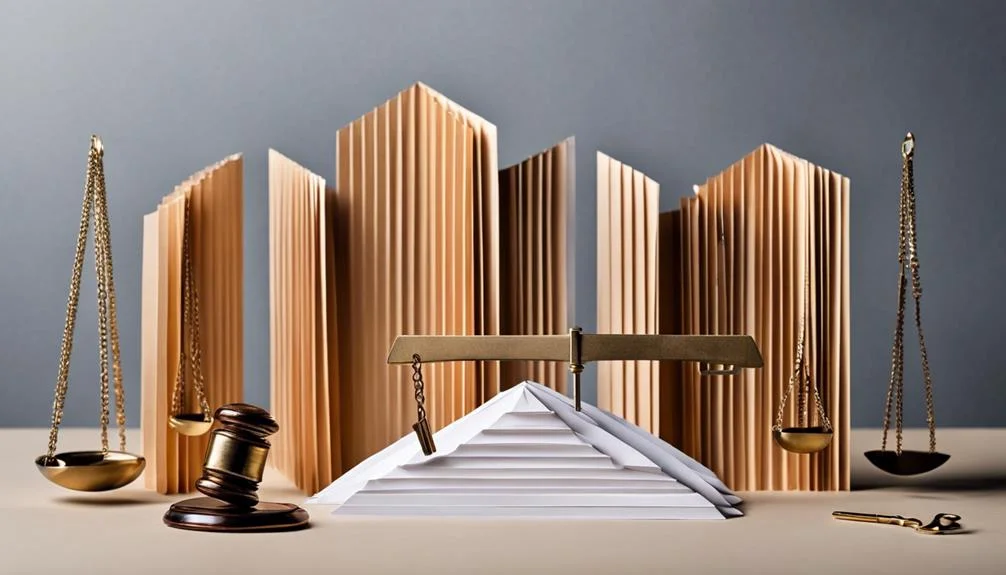Takeaways:
- The Exclusionary Rule ensures evidence is collected lawfully, upholding constitutional rights and legal fairness.
- It protects against unreasonable searches and seizures, enhancing individual freedoms and the presumption of innocence.
- Critics argue the rule might lead to guilty individuals being freed due to minor procedural errors.
- Balancing the rule’s protection of rights with public safety and confidence in the legal system remains a significant future consideration.
| Pros of the Exclusionary Rule | Cons of the Exclusionary Rule |
|---|---|
| Ensures adherence to constitutional rights | Allows guilty individuals to escape justice |
| Deters police misconduct | Does not directly penalize offending officers |
| Promotes judicial integrity | Can hinder law enforcement efforts |
| Protects the innocent | Emphasizes procedural technicalities over substantive justice |
| Encourages professional law enforcement | Leads to the exclusion of reliable evidence |
| Levels the playing field | Creates additional legal complexities |
| Reflects societal values | Can be inconsistently applied |
| Limits government overreach | May not effectively deter police misconduct |
| Promotes legal clarity | Undermines public safety |
| Strengthens public trust in the legal system | Places undue burden on prosecutors |
Pros of the Exclusionary Rule
- Ensures adherence to constitutional rights: The exclusionary rule reinforces the importance of the Fourth Amendment by requiring law enforcement to respect citizens’ rights against unreasonable searches and seizures. It compels officers to operate within legal boundaries, thereby upholding the constitutional guarantee of privacy and protection from arbitrary governmental intrusion.
- Deters police misconduct: By excluding evidence obtained through illegal means, the rule serves as a deterrent against police misconduct. It signals to law enforcement agencies that violations of constitutional rights will not be tolerated and that any evidence gathered unlawfully will be rendered useless in court, thus promoting lawful investigation methods.
- Promotes judicial integrity: The rule maintains the integrity of the judicial system by ensuring that courts do not become complicit in constitutional violations. It demonstrates the judiciary’s commitment to upholding the law and ensures that justice is served without compromising on legal principles and individual rights.
- Protects the innocent: By requiring a clear chain of evidence and adherence to legal procedures, the exclusionary rule helps protect innocent individuals from being wrongfully convicted on the basis of illegally obtained evidence. This is crucial in preventing miscarriages of justice and ensuring that the presumption of innocence is maintained.
- Encourages professional law enforcement: The necessity to follow legal procedures when collecting evidence encourages law enforcement officers to conduct more thorough and professional investigations. This professionalism can lead to more reliable evidence and stronger cases that are built on solid legal foundations.
- Levels the playing field: The rule offers a means for poorer defendants, who might otherwise be overwhelmed by the resources of the state, to challenge the legality of the evidence against them. This is crucial in ensuring that justice is accessible to all, regardless of economic status.
- Reflects societal values: By excluding illegally obtained evidence, society reaffirms its commitment to the rule of law and demonstrates that the ends do not justify the means. This upholds the moral and legal standards that govern a civilized society.
- Limits government overreach: The rule acts as a check on the power of the government by preventing law enforcement from overstepping their authority. It safeguards personal freedoms and protects individuals from the potential abuse of power by the state.
- Promotes legal clarity: The existence of the exclusionary rule clarifies the consequences of violating constitutional rights, providing law enforcement with clear guidelines for conducting searches and seizures. This clarity is essential for maintaining law and order while respecting individual rights.
- Strengthens public trust in the legal system: By ensuring that the law is applied fairly and consistently, the exclusionary rule helps build public confidence in the legal system. Trust is essential for the effective functioning of the judiciary and for the maintenance of social order.
Cons of the Exclusionary Rule
- Allows guilty individuals to escape justice: One of the most criticized aspects of the exclusionary rule is that it can result in clearly guilty individuals being acquitted if critical evidence is deemed inadmissible due to procedural errors. This can undermine public confidence in the criminal justice system and lead to frustration and distrust.
- Does not directly penalize offending officers: The rule focuses on excluding evidence rather than sanctioning the individual officers who violate constitutional rights. This lack of direct accountability does little to deter specific officers from repeating their unlawful actions, as the consequences are borne by the prosecution’s case rather than by the officers themselves.
- Can hinder law enforcement efforts: The strict application of the rule can sometimes impede law enforcement agencies’ ability to effectively investigate and prosecute crimes. It places a significant burden on the police to ensure that every piece of evidence is obtained in strict compliance with the law, potentially limiting their ability to gather all relevant information.
- Emphasizes procedural technicalities over substantive justice: Critics argue that the rule places undue emphasis on the method by which evidence is obtained, rather than on the truth or relevance of the evidence itself. This can lead to situations where the focus is on legal technicalities rather than on achieving substantive justice.
- Leads to the exclusion of reliable evidence: The rule mandates the exclusion of evidence that is reliable and probative, solely because it was obtained in violation of legal procedures. This can deprive the court of valuable information necessary for making informed decisions, potentially leading to wrongful acquittals or convictions.
- Creates additional legal complexities: The application of the exclusionary rule can lead to complex legal arguments regarding the admissibility of evidence, complicating trials and placing a heavier burden on the courts. These complexities can delay the judicial process and increase the cost of litigation.
- Can be inconsistently applied: The determination of what constitutes an “illegal search” can vary, leading to inconsistencies in the application of the rule across different jurisdictions. This inconsistency can undermine the rule’s effectiveness and lead to unequal treatment of defendants.
- May not effectively deter police misconduct: Some argue that the rule is not an effective deterrent against police misconduct, as officers might still take their chances with illegally obtained evidence, hoping it will not be challenged or that exceptions to the rule will apply.
- Undermines public safety: By potentially allowing guilty individuals to go free, the rule can pose a risk to public safety. This is particularly concerning in cases involving violent or dangerous criminals who may continue to pose a threat to society.
- Places undue burden on prosecutors: Prosecutors must carefully scrutinize the origins of all evidence to ensure its admissibility, which can divert resources from other aspects of case preparation. This additional burden can detract from the prosecution’s ability to present a strong case, especially in complex or resource-intensive investigations.
Sources:
exclusionary rule | Wex | US Law | LII / Legal Information Institute
Amdt4.7.1 Exclusionary Rule and Evidence
The Fourth Amendment and the Exclusionary Rule
How We Got the Fourth Amendment Exclusionary Rule
Exclusionary Rule Defined
What exactly is the exclusionary rule, and how does it serve to protect individual rights within the judicial system?
At its core, the exclusionary rule is a legal principle that prohibits evidence collected or analyzed in violation of the defendant’s constitutional rights from being used in a court of law. Originating from the Fourth Amendment, which was ratified in 1791, this rule underscores the U.S. legal system’s commitment to upholding citizens’ protections against unreasonable searches and seizures by law enforcement agencies.
The exclusionary rule was formally established by the Supreme Court in 1914 through the landmark case Weeks v. United States, setting a precedent that evidence obtained unlawfully by federal officers could not be admitted in federal courts.
This principle was further extended to state courts in 1961 via the Mapp v. Ohio case, significantly broadening its scope and application. The rule acts as a critical safeguard, ensuring that the government adheres to constitutional standards during criminal investigations and proceedings.
Historical Context

Understanding the origins of the exclusionary rule reveals its pivotal role in shaping the principles that govern evidence admissibility in U.S. courts. Established by the landmark case Weeks v. United States in 1914, this rule is deeply rooted in the Fourth Amendment, which protects citizens from unreasonable searches and seizures. Its establishment marked a significant shift in the way evidence was handled in the legal system, emphasizing the importance of constitutional rights over the mere convenience of law enforcement.
The extension of the exclusionary rule to state courts through Mapp v. Ohio in 1961 further underscored its fundamental role in safeguarding individual liberties across the nation. By requiring law enforcement to adhere to legal procedures when collecting evidence, the rule promotes fairness in trials and ensures that justice is not compromised by the misuse of power.
- Weeks v. United States (1914): Established the exclusionary rule, emphasizing Fourth Amendment protections.
- Mapp v. Ohio (1961): Extended the rule to state courts, bolstering protection against unreasonable searches.
- Aims and Impacts: Protects constitutional rights, promotes fair trials, and limits government power, enhancing the integrity of the justice system.
Pros of the Rule

Moving on to the advantages of the exclusionary rule, it’s pivotal to understand how it bolsters the integrity of the judicial system.
By mandating that evidence must be obtained through lawful means, it ensures that law enforcement agencies adhere to constitutional rights, thereby safeguarding individual freedoms.
This framework not only promotes fairness in legal proceedings but also fortifies the presumption of innocence, a cornerstone of justice.
Enhances Legal Integrity
The exclusionary rule plays a crucial role in upholding the Fourth Amendment by ensuring that individuals are safeguarded against unreasonable searches and seizures. By compelling law enforcement and investigators to adhere strictly to legal standards, it significantly enhances the integrity of the legal process. This rule not only fosters a meticulous approach to investigations but also ensures that the government bears the burden of proof, upholding the foundational principle of innocence until proven guilty.
- Ensures investigators adhere to legal boundaries, promoting meticulous legal work.
- Shifts the burden of proof onto the government, maintaining the presumption of innocence.
- Forces law enforcement to follow proper procedures, reducing the risk of constitutional violations.
Protects Individual Rights
Central to the preservation of democracy, the exclusionary rule serves as a fundamental safeguard of individual rights by mandating that law enforcement adheres to constitutional procedures in evidence collection. It enforces the requirement that warrants must be based on probable cause, thereby preventing arbitrary searches and seizures.
This limitation on government power is crucial for upholding the Fourth Amendment’s protections against unreasonable intrusion into citizens’ lives. Moreover, the rule promotes fairness in the judicial process by presuming innocence before proving guilt and demanding a clear chain of evidence.
It significantly reduces the risk of manufactured evidence and safeguards against wrongful convictions by maintaining the integrity of evidence. Through these mechanisms, the exclusionary rule plays a vital role in protecting individual rights and ensuring justice.
Cons of the Rule

Several drawbacks associated with the Exclusionary Rule significantly impact the judicial system and public safety. Initially designed to safeguard individuals’ rights by preventing the use of illegally obtained evidence in court, the rule has also led to unintended negative consequences. While its intentions are commendable, the practical implications have sparked debate over its overall efficacy and its impact on the justice system and societal safety.
- Release of Otherwise Guilty Persons: A significant drawback is the potential release of guilty individuals, including those who might be dangerous or violent, due to the inadmissibility of crucial evidence obtained in violation of procedural rules. This outcome can undermine public safety and trust in the legal system.
- Diminishment of Public Respect: The rule can lead to a perceived lack of accountability, eroding public respect and confidence in the legal and judicial system. When credible evidence is excluded, it can create a sense of injustice among the community, questioning the system’s ability to uphold law and order.
- Failure to Differentiate: The Exclusionary Rule does not distinguish between more and less serious crimes or willful versus accidental violations. This lack of nuance can result in the exclusion of credible evidence even in cases of minor procedural errors, affecting the outcome of potentially serious or high-stakes cases.
Legal Implications

The legal implications of the exclusionary rule extend beyond its immediate effect on criminal proceedings.
By enhancing judicial integrity, the rule ensures that courts are not complicit in using unlawfully obtained evidence, thereby maintaining the justice system’s credibility.
Additionally, it serves as a deterrent against police misconduct and has a profound impact on the approach and outcome of prosecutions.
Enhancing Judicial Integrity
Upholding judicial integrity, the exclusionary rule plays a pivotal role in ensuring that evidence obtained through illegal means is not admitted in court, thereby maintaining the fairness and credibility of the judicial system. By strictly enforcing this rule, courts signal a strong commitment to the rule of law and constitutional rights, which is fundamental for the preservation of public trust and the effective administration of justice.
- It reinforces the Fourth Amendment by protecting individuals from unlawful searches and seizures.
- Maintains the credibility and fairness of the judicial system by excluding evidence obtained through misconduct.
- Encourages lawful and ethical behavior among law enforcement officials, thereby reinforcing public trust in the legal process.
Limiting Police Misconduct
Building on the foundation of enhancing judicial integrity, the exclusionary rule also plays a critical role in curbing police misconduct by mandating strict adherence to legal standards during investigations. This rule limits police misconduct effectively by requiring that evidence collection processes comply with legal procedures. It acts as a deterrent against illegal search and seizure practices, ensuring that law enforcement officers conduct their investigations within the bounds of the law.
Violations of this rule can lead to the suppression of unlawfully obtained evidence, promoting accountability and ethical conduct among police officers. Upholding the exclusionary rule is essential for protecting individuals’ constitutional rights, as it prevents evidence acquired through misconduct from being used in court, thereby maintaining the integrity of the judicial process.
Impact on Prosecutions
While designed to safeguard constitutional rights, the exclusionary rule significantly influences the dynamics of criminal prosecutions by potentially omitting pivotal evidence. This rule, aimed at deterring police misconduct, poses significant challenges for prosecutors who must build their cases without evidence obtained in violation of constitutional mandates.
The legal landscape necessitates meticulous navigation to ensure the admissibility of evidence, directly impacting the outcomes of criminal prosecutions.
- Prosecutors face increased challenges in proving guilt without access to crucial, albeit illegally obtained, evidence.
- The rule necessitates a higher burden of proof on the prosecution, compelling them to establish cases without tainted evidence.
- Legal complexities around evidence admissibility under the exclusionary rule can decisively influence the outcome of criminal prosecutions.
Public Perception

Public perception of the exclusionary rule is deeply divided, reflecting broader societal views on the balance between ensuring justice and protecting individual rights. On one hand, a segment of the population views the rule as a crucial safeguard against unlawful searches and seizures, valuing its role in upholding the constitutional rights of individuals. This perspective emphasizes fairness and justice in legal proceedings, advocating for the rule’s importance in maintaining the integrity of the judicial system.
Conversely, there are those who criticize the exclusionary rule for its potential to hinder the prosecution of criminals, fearing that it might allow guilty parties to evade justice due to technicalities. This viewpoint often stems from concerns over public safety and a desire for a more stringent approach to law enforcement and legal accountability.
Trust in the justice system is significantly affected by these differing perceptions. Debates surrounding the rule frequently center on its implications for law enforcement accountability and due process, highlighting the complex relationship between individual rights and collective security. Moreover, public awareness and understanding of the exclusionary rule’s role in protecting constitutional rights significantly influence attitudes toward legal procedures and the handling of evidence, shaping the overall trust in judicial processes.
Future Considerations

As we look toward the horizon, future considerations of the exclusionary rule necessitate a thoughtful examination of its limitations and opportunities for enhancement to better serve justice and societal needs. The evolving dynamics of criminal justice, alongside shifts in societal norms and legal practices, underscore the need for a rigorous review and potential recalibration of the rule. This would ensure its principles are aptly aligned with contemporary challenges, thereby fostering a legal environment that upholds the delicate balance between enforcing the law and protecting individual rights.
To navigate the complexities ahead, key areas for consideration include:
- Reforms to Address Limitations: Identifying and implementing changes that streamline the rule’s application, reducing instances where its execution may inadvertently shield the guilty or impede justice.
- Balancing Rights with Law Enforcement Needs: Exploring innovative strategies that respect individual liberties without undermining the efficacy of law enforcement.
- Modernization in Response to Societal Changes: Adapting the rule to reflect technological advancements and evolving societal expectations, ensuring its relevance and effectiveness in modern legal contexts.
These considerations represent pivotal steps towards refining the exclusionary rule, aimed at reinforcing its foundational purpose while accommodating the demands of today’s legal and social landscape.
Conclusion
In conclusion, the Exclusionary Rule stands as a crucial component of the judicial system, balancing the scales between individual rights and law enforcement responsibilities. Despite its contentious nature, highlighted by arguments regarding potential impediments to justice and administrative burdens, the rule underscores the paramount importance of upholding constitutional protections and ensuring fair legal proceedings.
As society evolves, continuous evaluation and adaptation of this doctrine are essential to maintain its relevance and effectiveness in safeguarding civil liberties and promoting legal accountability.










